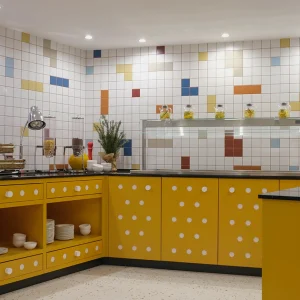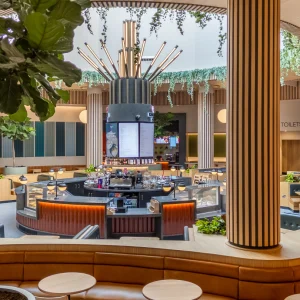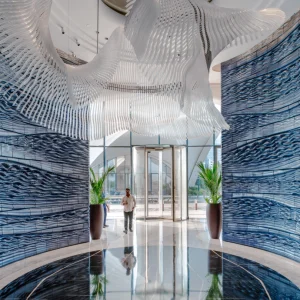
Doriana Mandrelli
Doriana Mandrelli was born in Rome, where she graduated in history of art from La Sapienza University in 1979. She subsequently attended the architecture school at the same institution. Her partnership with architect Massimiliano Fuksas dates back to 1985. ‘I have never worked for another architect,’ she says.
Fuksas and Mandrelli divide their time between an apartment in centre of the Italian capital and another in the Place de Vogues in the fashionable Marais district of Paris. Mandrelli’s connection to France also takes the form of admiration for designer Jean Prouvé. She owns a credenza and a replica of the French designer’s steel doors with round windows on display at the Pompidou Centre.
An admirer of Frank Lloyd Wright’s Fallingwater, her own work is characterised by continuous research into new materials and new techniques of manufacturing. This can be seen in the Candy collection of lamps for Zonca, launched earlier this year. The geometric design consists of 12 pentagonal sides covered in a multiporous surface.

For more than a decade Mandrelli has worked on projects for Giorgio Armani: ‘He has a very strong character and we have done five projects for him, which are all different.’ She admires the Fuksas New York store for Armani for its connection with its surroundings, with the facade taking its cues from location, in this case the Manhattan street grid. Inside images and colours are projected on to an LED curtain, while the staircase is the centrepiece of the building. Made of rolled steel coated in plastic to enhance its sculptural effect, it swirls around the ground floor and the two levels above. The lighting emphasises the curvature of the walls and spaces while the choice of putty colour for the walls and black for the ceilings and marble floors give a nod to Armani’s signature neutral shades. The Armani Chater House in Hong Kong, meanwhile, is defined by a red varnished stripe that rises from the floor, lifts up to form a table before descending to accommodate the restaurant.
In terms of change in the 30-plus years Mandrelli been in the architecture and design business, she says: ‘Software is probably the most important change. Even if you use 3D programs, I still like to have physical models.’ One change for the worse is what she sees as a homegenous nature of design: ‘It was easier to be original during the Renaissance or Baroque periods. These days, everybody can see everybody else’s work, it’s a big melting pot but then everyone’s the same.’
Fuksas and Mandrelli’s Rome apartment features lighting by Forties’ Japanese designer Noguchi and a painting by Argentine-born artist Lucio Fontana, but Mandrelli wishes the city had a similar modernity to the painting. ‘For a long time, everything in Rome was frozen,’ she says. ‘Things are changing, there are a few new buildings; maybe it will be like India or China and a new generation will get the chance to do exciting things.’
Richard Schultz
Richard Schultz is not a fan of today’s task chairs made of mesh, most famously promoted by Herman Miller. But then Schultz has always had something of a friendly rivalry with the Michigan firm, as he remembers fondly: ‘There was always great competition between the Eameses in LA and their work for Herman Miller and Knoll in Pennsylvania.’

Courtesy of KNoll, iNc.
Schultz is an integral part of the Knoll story in the 20th century. He studied mechanical engineering design at Iowa State University and the Illinois Institute of Technology of Chicago, which Schultz, and specialist in outdoor furniture, calls ‘the new Bauhaus’. After he joined Knoll in 1951, he says that ‘at first my time was spent making a model of a secretarial chair. It was really sculpture, not furniture design’. His big break came when he assisted Harry Bertoia on the development and production of the Bertoia Wire Collection. Bertoia was an alumnus of Cranbook Academy of Art, as was Charles Eames, and together they developed methods of laminating and bending plywood.

Richard Schultz’s table and chairs from the 1966 Leisure Collection for Knoll Photo credit: Hub Willson
In Schultz Bertoia found a designer similarly obsessed with pushing the boundaries of materials. ‘The bend in each wire is different. Every single joint is separately welded. At the time, it was a completely invented technique,’ Schultz recalls. He was encouraged by Bertoia to ‘do something you’d like to furnish your house with’. The development of the collection then led to an 18-month assignment in Europe, which saw Schultz establishing and supervising production of the Bertoia designs for various subsidiaries and licensees of Knoll.
On his return, he joined the Design Development Group at the Knoll factory. Arguably his most famous design, the outdoor Petal Table, introduced in 1960, was originally intended to accompany the Bertoia chairs. The tabletop is made of eight petals mounted on a crafted, cast aluminium ‘spider’. ‘I was inspired by Queen Anne’s Lace, a weed that grows near our house in Pennsylvania. Each flower cluster is supported on its own stem. By making a table in this manner there is no need for ring support and each petal is independent, which allows the table to expand and contract with the weather,’ he says. Testament to its design credentials, the table was immediately included in the MoMA Design Collection. His steel wire-formed 715 Chaise Longue was introduced the following year.

Petal Table (1960), now among his designs being rereleased Photo credit: Hub Willson
Florence Knoll was one of the key people in Schultz’s career. The architect, furniture designer and business partner with her husband Hans Knoll, she began sending the design team rusty pieces of furniture, asking them to develop something that could withstand weather conditions. Schultz’s response in 1966 was the aluminium Leisure Collection. Schultz continued with outdoor furniture, designing for his own studio and harnessing his technical skill, obsession for detail and love of sculptural forms. In a neat piece of historical design come full circle, Knoll acquired Richard Schultz Design in 2012, enabling the rerelease of many of his classic Knoll designs, including the Petal Table.
George Ciancimino
It’s hard to believe but designer George Ciancimino could have been lost to the world of banking were it not for a man he met in the Fifties whose profession was to orient people towards an appropriate vocation. ‘He advised me that I should somehow be in the arts. This casual encounter changed my life forever,’ Ciancimino recalls.

George Ciancimino’s work includes, clockwise from top left, the Paris 83 cafe table (1983), detail from the Cloverleaf system (1973), and the sculpture Maze#2 (2011). His work was also licensed to Mobilier International in France and OUN in Japan
Born in 1928 in Algeria, his mother remarried an English officer and he came to live in England after serving in the navy. His career has taken him around the world, from working as a sculptor and ceramicist in Paris to design and interiors in Canada before returning to London and joining his brother Jean-Claude in opening an antiques shop, dealing in antiquities and medieval art. ‘In the late Sixties, I decided to branch out into designing my own products. Zeev Aram and I were the only two people selling modern furniture on the King’s Road. It was a challenging time as modern furniture was not in vogue in England,’ he says.

‘My first break was designing a range of furniture for Jens Risom in the USA, which he showed at the Chicago Fair.’ Having had no formal training, he says he had to learn from his mistakes: ‘I believe it is an integral part of understanding one’s craft.’ His style blended his interest in Japanese craftsmanship with a passion for modern industrial processes. Companies such as Martinez Medina of Spain and Steelcase in the UK licensed his work. The James Bond film Diamonds are Forever featured a collection by Ciancimino in the penthouse of villain Willard Whyte, including tables with solid aluminium and smoked-glass tops, lamps that turn on and off at the swivel of a polished chrome tube and an ashtray where cigarette ash and stubs slip discreetly out of sight between stylish metal spheres.
Typical of his work is the Paris 83 table, an adaptation of a traditional Parisian coffee table. This art deco-like design has a tripod base, prong-type supports and a simple base, constructed in cast iron and finished in Nextel. He has also designed private residences and offices for clients that include Bear Sterns, Seagram and British Airways.

He admires the work of Robin Day for Hille and what Terence Conran did for modern design with Habitat, but it is Pentagram which evokes the most passion in Ciancimino. ‘Its various disciplines under one roof was a brilliant concept. Alan Fletcher was always a great influence and wonderful friend. I was once quoted as saying that Pentagram was "the best thing that had happened since the Bauhaus". Each member brought their individual talents.’ Of today he says: ‘3D printing will alter the world as it helps to speed up the creative process of artists and designers. Technology changes everything, but I still like the feel of pen on paper.’ Not one to rest his creative laurels, Ciancimino continues to produce work. ‘I am a sculptor. This is my life now,’ he says.
Kaffe Fassett
Although textile designer Kaffe Fassett was born in San Francisco in 1937, England has been his home since 1964. Aged 19, he won a scholarship to the Museum of Fine Arts School in Boston, but left after just three months to paint in London. A visit to a Scottish wool mill proved a turning point. He bought 20 colours of Shetland wool and knitting needles and on the train back to London a fellow passenger taught him how to knit. And so began began his still continuing voyage of discovery into colourful textiles.

Kaffe Fassett’s work recently on show at the Welsh Quilt Centre in Lampeter
Scottish fashion designer Bill Gibb and Italian fashion house Missoni were early supporters of Fassett’s work. He recalls a sage piece of advice from a female painter: ‘When I complained about liking what I was doing too much, she said, "Take what you like and do it the best you can".’
His designs have been worn by everyone from film stars to royalty. ‘There was a freedom and creative spirit back in Sixties and Seventies that brought a lot of talent to the surface. I feel it is harder these days to attract the publicity that encourages burgeoning careers. Radio and TV seem less inviting of new or odd talent,’ he says.

Fassett at work
A career highlight of his own, he says, was ‘being the first living textile designer to have a one-man show at the Victoria and Albert Museum’. That was in 1988 and since then ‘textiles are taken more seriously by museums’. Fassett’s needlepoint designs have graced everywhere from Marks and Spencer to Christopher Farr, and from an Elizabethan house in Yorkshire to a Sea Princess Cruise Liner. Over the years, he has learned that ‘it is better to wait till someone is hungry [enough] to seek you out; it is rarely profitable to go out seeking companies to use my designs. Also stay loyal to a firm as long as possible to allow proper development to take place for you both to benefit’. He has worked with Oxfam, which asked Fassett to work with poverty-stricken weaving villages in India and Guatemala, to advise on designs that would be more marketable in the West. As a result a range of colourful hand-woven fabrics is being produced for use in shirt making, bed throws and patchwork through Rowan UK and American company Westminster Fibers, which also distributes much of Fassett’s work.
Fassett continues to teach quilt-making all over the world, sharing his unique sense of colour. This year has been an incredibly busy one for him. As well as exhibiting at London’s Fashion and Textile Museum and having a recent show at the Welsh Quilt Centre in Lampeter he was the recipient of the Turner Medal. This biennial prize, awarded by the Colour Group of Great Britain and jointly sponsored by the Royal College of Art is given to a distinguished artist or art historian.
And the future? ‘I’m excited that people in the design world are using more colour, even in cars. Perhaps the long funeral that has affected the design industry is beginning to break up and we shall experience colour in our everyday lives.’





